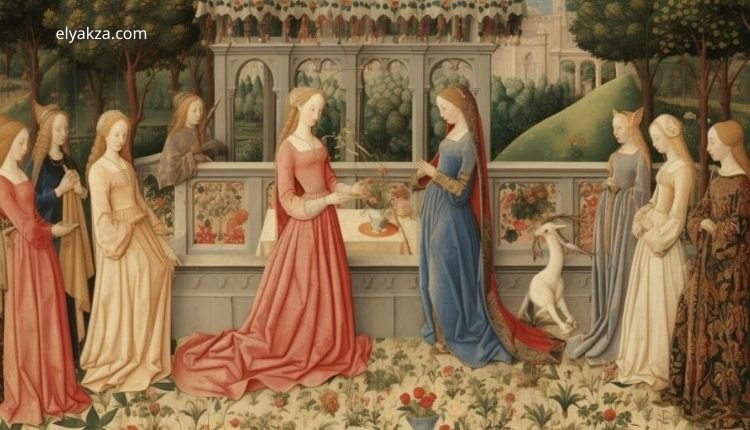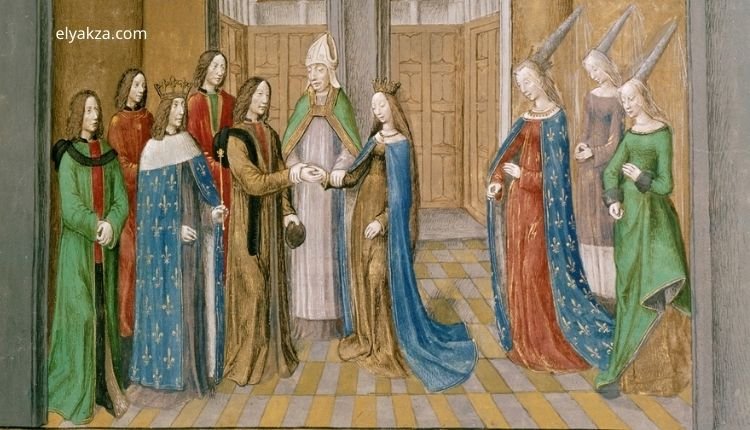Minds have long been captivated by the worlds of medieval kings, not only by their battles and victories but also by the private aspects of their lives, especially those related to intimacy and sexual practices. In an era where power extended to the most intricate details of personal life, desire and procreation transformed into complex political arts, practiced under the watchful eyes of courtiers and sometimes even the public. Royal chambers were not merely places for sleep; they were stages where the deepest secrets and most peculiar rituals unfolded.
قائمة المحتويات
This article takes you on a journey into the hidden corridors of palaces, revealing the strangest sexual and intimate practices that characterized the lives of medieval monarchs, and illustrating how desire was an instrument no less significant than the sword in shaping the destiny of kingdoms.
Intimacy as a Performance Art: The King’s Bedchambers
Medieval royal bedchambers were not private sanctuaries in the modern sense. Instead, they were extensions of the throne room, where politics and pleasure intertwined. The idea of the sacred privacy of royal moments is a modern invention. In those times, intimacy could be a performance, a message, or even a negotiation.
Rituals and Symbols of Desire
Every detail had its own language; three stacked pillows meant comfort, while two at an angle signified a serious discussion. Even the colors of the drapery determined the tone of the night: red for passion, green for renewal, gold for triumph, and blue for divine blessing. The king managed desire precisely as he managed diplomacy. Every movement, every touch, and every glance was part of an intricate dance aimed at enhancing his image and authority, even in the most profoundly personal moments. He carefully selected curtain colors and moved deliberately towards the bed, all part of nocturnal rituals where pleasure itself became an act of state.
Royal Fertility Pageants: When Desire Becomes Public Politics
Proving the king’s fertility and producing an heir was crucial for the continuity of dynasties. Thus, it was not uncommon for some kings to organize what were called “fertility pageants,” semi-public displays that blurred the lines between royal duty and theater.
Public Consummation and Political Assurance
These practices were not as crude as one might imagine, but they were certainly not subtle. The royal hall would be adorned with golden banners and fruits symbolizing abundance and life, such as figs and pomegranates. Poets would recite verses about blooming orchards and swelling rivers, using thinly veiled metaphors.
Historical sources indicate that royal consummations were semi-public events in some European courts, attended by witnesses to guarantee the fulfillment of marriage contracts and the sealing of alliances. While this may seem invasive today, it was then considered a safeguard for both the legitimacy of heirs and the honor of the bride. On one occasion, a king insisted that the entire fertility pageant be timed to the exact moment deemed most auspicious for conception by the astrologer, which could keep the court waiting for hours. After the final blessing, the king would take the queen’s hand with theatrical gravity, fully aware that all eyes were upon him. These pageants were essential for boosting court morale and convincing foreign ambassadors of the inevitability of an heir, thereby reinforcing the image of royal power.
“Read ALso: TOP TEN MISCONCEPTIONS ABOUT ISLAM“
Peacock Feather Potions: Stirring Royal Desire

In an attempt to enhance desire, medieval kings resorted to bizarre and unconventional concoctions. One of these peculiar practices involved “peacock feather potions” that the king insisted on consuming.
Theatrical Alchemy and Royal Authority
These potions were made from peacock feathers, allegedly plucked from live peacocks under the light of a waxing moon, then mixed with wine, honey, and other secret substances. The royal alchemist would prepare them in front of the king, adding saffron to the embers in a highly ceremonial ritual.
Medieval courts strongly believed in aphrodisiacs made from exotic or visually impressive ingredients, from powdered gemstones to rare spices. However, this particular king took the tradition to extreme lengths. The rarer the ingredient, the more magical and potent it was believed to be. The king himself would attend the potion-making process, sipping it with exaggerated appreciation. But the true magic lay not in the ingredients themselves, but in the theatrical performance designed to remind everyone present that the king’s desires—and thus his power—were tended with the same care as his armies and treasury.
“Read Also: Why Islam is the True Religion“
Bedchamber Surveillance: When Intimacy Comes Under Scrutiny
Imagine your intimacy being subjected to scrutiny by auditors! This is what happened in this king’s court. In his royal bedchamber, small stools held writing kits, not prayer books. Trusted royal chamberlains observed every detail: the number of candles, the amount of incense, and even the precise arrangement of pillows.
Inspectors and Intimate Reports
These “inspectors” would record everything in special ledgers, from the count of linens and candles to the king’s movements and his retinue. Their work was not voyeurism but testimony. The kingdom needed heirs, and noble families required assurance that the marriage had been consummated.
The most senior inspectors would even record the “quietness” of the room using small symbols, believing that a serene bedchamber produced serene heirs. These subtle details reveal a world where even the most intimate actions were part of the complex machinery of royal power. These nightly reports were a blend of intimate chronicle and strict logistics, confirming that no moment of the king’s life, even in his bed, escaped the control of the crown and the observation of his trusted attendants.
“Read Also: Best Bikini Brands of 2025“
The Trial of Passion: Sacred Seduction Games
In an attempt to blend piety with desire, the king orchestrated “saintly seduction trials,” private encounters that pretended to be sacred but were in reality elaborate seduction roleplays cloaked in religiosity. The chamber, designed to resemble a chapel, was divided by an ornate carved wooden screen.
Roleplay, Symbolism, and Desire
The ritual began with the ringing of a small bone-carved bell, signaling the start of the “game.” The guest would confess sins or temptations, fictional or real, while the king responded as confessor, saint, or occasionally penitent himself. The king would then present three temptations on a silver tray: a ruby ring, a vial of rose oil, and a bone-carved key, from which the guest had to choose one.
There was no consensus among historians as to whether these trials were elaborate courting rituals, political allegories, or merely the king’s private entertainment. Still, they certainly reflected the king’s deep interest in symbolism and the control of concepts of desire and virtue.
The Feast of Secrets: Cuisine as a Weapon of Control

In the castle kitchens, where the aroma of fine foods mingled, the “Feast of Secrets” was held. This feast was not just a banquet; it was an experiment in indulgence and revelation, where each dish served carried not only flavor but also hidden meaning.
Food, Power, and Hidden Tests
The king closely observed how his guests ate and interacted with each dish, as he did not partake in the meal himself. Instead, he watched to see who could control their desires and who succumbed to pleasure.
For example, a dish of honeyed pheasant symbolized abundance but tested the guest’s ability to resist excess. On one occasion, delicate pastries filled with rare herbs said to induce relaxation were served, allowing the king to observe how his courtiers behaved when their defenses were lowered. This feast was a means for the king to gather information about his courtiers, as each guest revealed their true nature through their choices and interactions with the food.
“Read Also: top 10 essential World War 3 survival gear“
The Strangest Sexual Practices of Medieval Kings: the Conclusion
Our journeys through the secrets of medieval kings have unveiled a world where intimacy, the body, and desire were integral to the art of governance. Sexual practices were not merely private matters; they were transformed into political rituals, displays of power, and tools for controlling the court and the kingdom.
From surveilled bedchambers to public fertility pageants, from bizarre peacock potions to the Feast of Secrets, every detail reflected a profound understanding of the relationship between the body, desire, and authority. These secrets, long kept under wraps for centuries, now show us how kings wove a complex tapestry of performance and reality, transforming the most intimate details of their lives into chapters in the history of rule and control.
مها أحمد كاتبة ومدونة تقدم محتوى متنوعًا يجمع بين التجربة الشخصية والتحليل الموضوعي. تكتب عن قضايا اجتماعية وثقافية وفكرية بأسلوب سلس يلامس اهتمامات القارئ اليومية.
تمتاز بأسلوبها العفوي الذي يدمج بين الطابع الشخصي والتعبير الحر، مما يجعل التدوينات قريبة من القارئ وواقعية. كما تحرص على طرح أفكار جديدة ومناقشة قضايا مجتمعية بطريقة مفتوحة للنقاش.
من خلال مدوناتها، تسعى مها أحمد إلى مشاركة الأفكار والخبرات وتبادل الرؤى مع الجمهور، لتجعل من التدوين مساحة للتواصل والإلهام.

